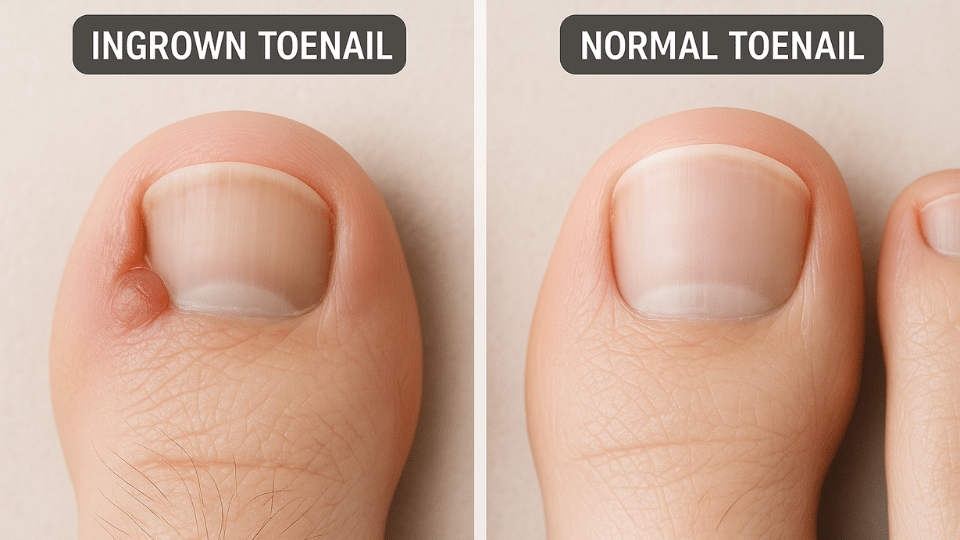An ingrown toenail can be an incredibly painful and irritating condition. It occurs when the edge of your toenail grows into the skin surrounding it, causing pain, swelling, and potential infection. If you’ve ever had an ingrown toenail, you know just how uncomfortable it can be. While some may attempt to treat it on their own, visiting a podiatrist ingrown toenail is often the best course of action to avoid complications and ensure quick relief.
In this article, we’ll explain why seeing a doctor for an ingrown toenail is essential for proper treatment and healing. At Fall Creek Foot & Ankle, our podiatrists specialize in treating ingrown toenails and can help you get back on your feet with minimal pain and discomfort
What Causes an Ingrown Toenail?
An ingrown toenail usually forms when the edge of the toenail grows into the soft skin of the toe, leading to pain and swelling. There are several factors that can contribute to this condition:
Improper Nail Trimming
Cutting toenails too short or rounding the edges can cause the toenail to grow into the surrounding skin, leading to irritation and potential infection.
Tight or Ill-Fitting Shoes
Wearing shoes that are too tight or have a narrow toe box can put excessive pressure on the toenails, encouraging them to grow into the skin.
Trauma or Injury
Injuries to the toe, such as stubbing it or dropping something on it, can cause the toenail to grow abnormally, leading to ingrown toenails.
Genetics
Some people are more prone to developing ingrown toenails due to the natural shape of their toenails or feet. Genetic factors can make the toenail more likely to grow into the skin.
Improper Footwear
Wearing tight, narrow shoes that don’t allow the toes to spread naturally can increase the pressure on the toenail, contributing to an ingrown toenail.
For more in-depth information on the causes of ingrown toenails, check out our article on The Where-To and Why-For of Ingrown Nails.

Why You Should See a Podiatrist for an Ingrown Toenail
While many individuals attempt to treat an ingrown toenail on their own, seeing an ingrown toenail doctor is essential for proper care and long-term relief. Here are several reasons why is important:
Professional Diagnosis and Treatment
A podiatrist can properly diagnose the severity of the ingrown toenail and recommend the best treatment plan. This may include gentle removal of the nail or part of the nail, as well as infection control. A podiatrist will ensure the area is cleaned properly and will provide advice on how to prevent the problem from recurring.
Prevention of Infection
Ingrown toenails are susceptible to infection, especially if they are not treated properly. A podiatrist can clean the affected area and, if necessary, prescribe antibiotics or topical ointments to prevent infection. Left untreated, an ingrown toenail can cause an abscess or spread to surrounding tissues, leading to more serious complications.
Minimize Pain and Discomfort
Ingrown toenails can cause severe pain, especially when pressure is applied. A podiatrist will ensure that the area is numbed properly before any procedures are performed. With professional care, the pain is minimized, and recovery time is reduced.
Proper Nail Care and Post-Treatment Advice
After the ingrown toenail is treated, a podiatrist will provide detailed instructions on how to care for the toe during the healing process. This can help reduce the likelihood of future ingrown toenails. They may recommend proper nail trimming techniques, suitable footwear, or custom orthotics to ensure long-term foot health.
Surgical Options for Severe Cases
In some cases, if the ingrown toenail is recurrent or severely infected, a podiatrist may recommend a minor surgical procedure to remove part of the toenail or the nail bed. This procedure is typically quick and effective, offering long-term relief for patients suffering from chronic ingrown toenails.
Prevention Tips for Ingrown Toenails
After treatment, it’s essential to take steps to prevent future ingrown toenail occurrences. Here are some expert tips:
Trim Toenails Properly
Cut toenails straight across, avoiding rounding the edges. Don’t trim the nails too short, as this can increase the risk of the toenail growing into the skin.
Wear Proper Footwear
Ensure that your shoes are comfortable, well-fitting, and provide adequate space for your toes. Tight or narrow shoes can cause pressure on the toenails, contributing to ingrown toenails.
Protect Your Feet During Activities
If you engage in activities that involve a lot of movement or pressure on your feet, such as sports, make sure to wear protective footwear to prevent injuries to the toenails.
Keep Feet Clean and Dry
Proper foot hygiene is key to preventing ingrown toenails. Make sure to wash your feet regularly and dry them thoroughly, especially between the toes. }
Use Custom Orthotics if Needed
If your feet have structural issues like flat feet, custom orthotics can help by providing the necessary support and reducing pressure on your toes, which can prevent the formation of ingrown toenails.
For more detailed expert advice on how to prevent ingrown toenails, check out our How to Prevent Ingrown Toenails: Expert Tips from a Podiatrist blog.
How a Podiatrist Treats Ingrown Toenails
When you visit a specialist, they will assess the condition of your toe and develop a personalized treatment plan. Common treatment options include:
Conservative Care
For mild ingrown toenails, a podiatrist may recommend conservative care, such as soaking the foot in warm water, applying antibiotic ointment, and wearing loose-fitting shoes to relieve pressure.
Nail Removal
If the ingrown toenail is causing significant pain or if conservative measures don’t work, the podiatrist may remove part or all of the toenail. This can be done with local anesthesia, ensuring the procedure is painless.
Partial Nail Matrix Removal
In severe cases where the ingrown toenail keeps recurring, a podiatrist may perform a procedure to remove the part of the nail matrix responsible for growth. This helps prevent the nail from growing back into the skin.
When to See a Podiatrist
If you’re experiencing pain, swelling, or redness around your toenail, it’s time to see an ingrown toenail doctor. A podiatrist can offer timely care to prevent infection and ensure your foot health is maintained. Don’t wait for the pain to worsen!
At Fall Creek Foot & Ankle, our team of experienced podiatrists is here to help you with all your foot and ankle concerns, including ingrown toenails. Whether you need simple treatment or more advanced care, we’re here to help you.
Contact us today to schedule an appointment with one of our experts.
